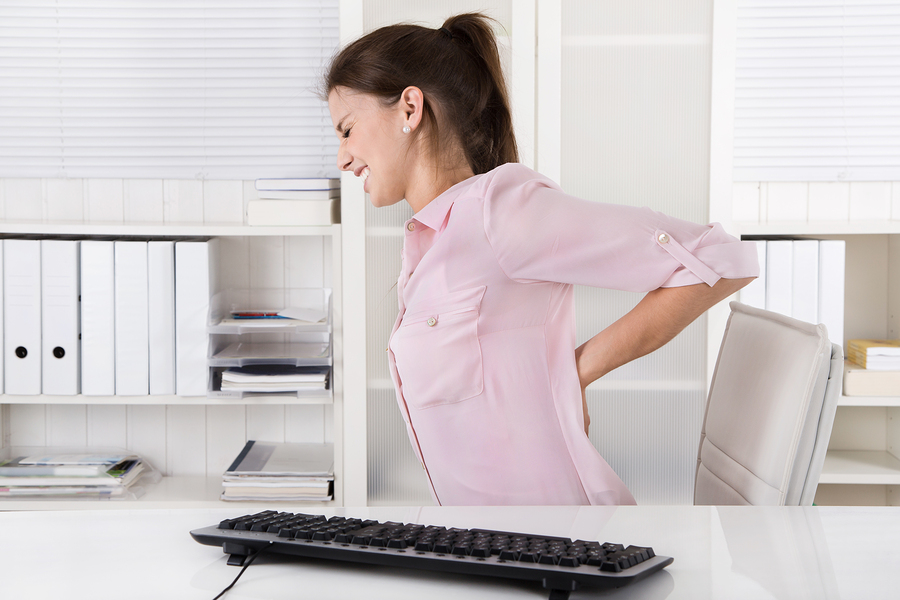
Our Toronto physiotherapy clinics treat professional and amateur athletes, but they aren’t the only people to experience injuries and conditions that affect the musculoskeletal system. Even people who sit at a desk all day can experience such injuries and conditions and the most common is lower back strain.
Chronic back strain affects many people and can be extremely debilitating, affecting not only your work day but your life and activities overall. It can contribute to many other health issues including difficulty in sleeping.
Here are some tips on how to ease and help prevent back pain at work.
Know the causes
Our Toronto physiotherapy clinics see many clients with back issues and some of them aren’t aware of what has caused the problem. Knowing what causes back pain can help you to prevent it before it happens as well as ease an existing condition.
- Slouching and other issues related to bad posture put undue strain on your lower back;
- Immobility – staying in the same position for long periods of time causes over-strain;
- Phone habits – holding the phone with your shoulder against your ear while you type on the screen.
Your Work Environment
Your desk and chair play a crucial role in back strain and how it may develop. When you sit at an unnatural posture over long periods of time, it results in stress, strain and injury.
- Leaning forward causes back strain, so you want to support the natural curve of your back with a chair that has proper lumbar support. A pillow behind your back can add additional support.
- You want your feet to be flat on the floor with your knees bent at about a 90-degree angle. A footrest or other prop can help your to achieve a better alignment.
- Arms should also be at a roughly 90-degree angle so that your shoulders aren’t hunched over, which can cause significant upper back pain. Adjusting your armrests to an optimal angle can make a big difference. Your upper arms should be parallel to your spine. An armrest at the proper alignment takes the strain of your shoulders and upper back.
- Your monitor should be slightly below eye level and about an arm’s length away so that you aren’t leaning forward.
- Thighs should not rest on or press down on the edge of your chair. You want to be able to slip your finger underneath to avoid reducing circulation.
Nowadays, there are also options other than the traditional office chair, including a Swedish kneeling chair or a Swiss exercise ball. These two options encourage you to use your muscles for balance rather than slumping back into the chair.
The Phone
If you are on the phone all day, how you use it can contribute significantly to upper back pain, as well as problems with your neck and shoulders.
- A headset or speaker phone leaves your hands free to take notes so you won’t be tempted to slip it between your ear and shoulder.
- Switch the phone between your left and right hand to avoid over straining either side.
Sit, stand, move
Sitting the same position for hours at a time can contribute to many other issues, including heart disease, as well as weakening lower back muscles.
- Take mini-breaks during the day at least once every hour. This can involve something as simple as going for a glass of water or cup of coffee or stretching for about 60 seconds.
- A sit-stand work station lets you alter your position over the course of the day. Recent research suggests that at least half your day should be spent standing rather than sitting.
- Good stretches can improve flexibility and keep pain at bay.
- Exercise to strengthen your core muscles and encourage proper posture.
- Taking a 15 to 20 minute walk at lunch time will help to keep muscles and joints looser.
Our Toronto based physiotherapists would be happy to discuss any back pain issues that you may be experiencing and help you determine a work day solution that is tailored for your situation. Call us today to make an appointment.
Sources:
https://www.bluezones.com/2012/05/easy-steps-to-relieve-back-pain-at-work
http://www.spine-health.com/wellness/ergonomics/office-chair-how-reduce-back-pain
http://www.webmd.com/back-pain/america-asks-13/12-back-pain-tips















